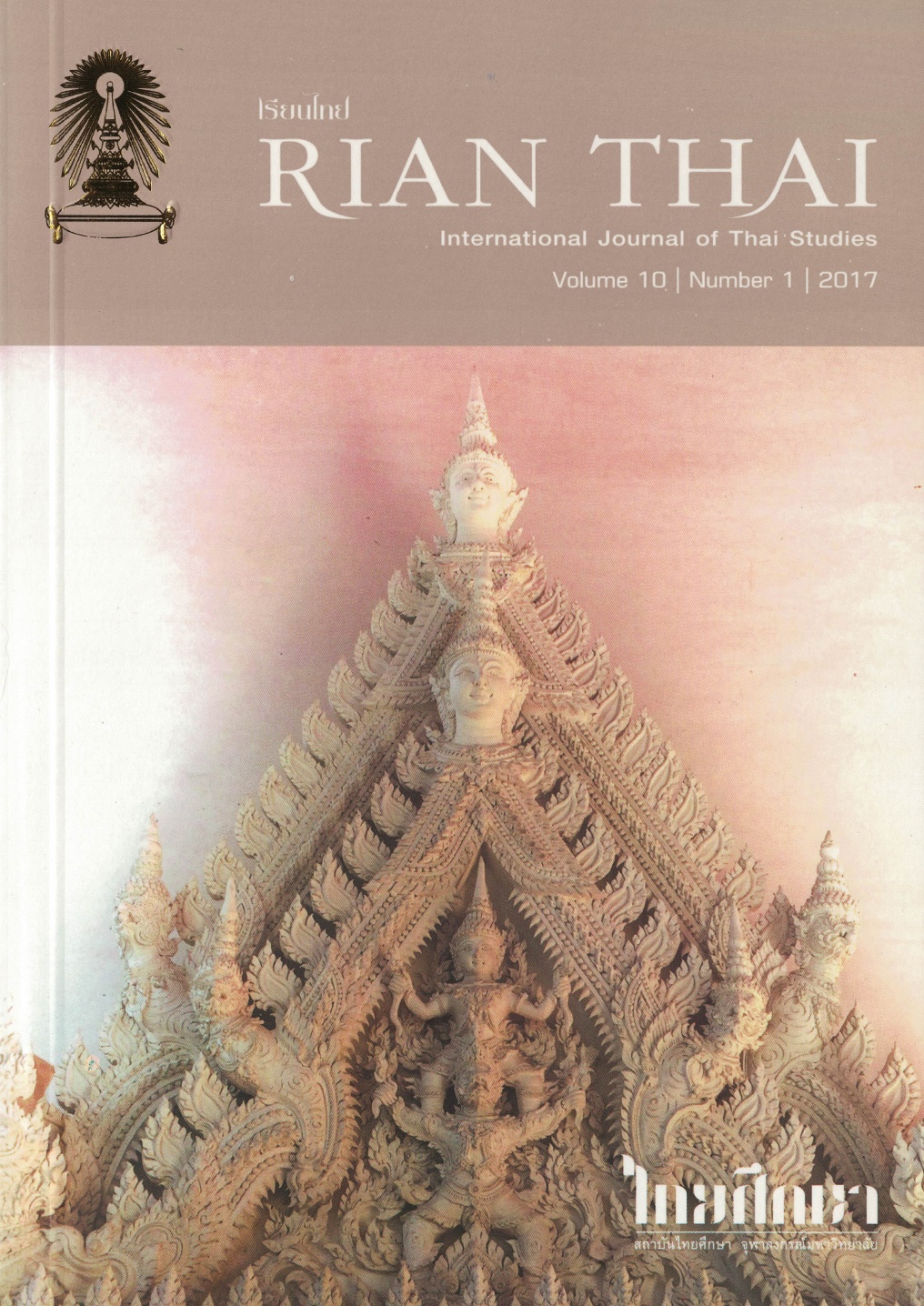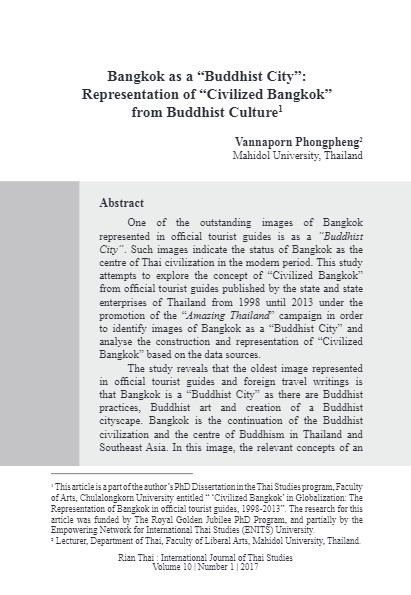Rian Thai - Volume 10/2017 (Number 1)

1) Renewal and Engagement : The Thai Roots of Sulak Sivaraksa’s Buddhist Thought / Jordan Baskerville
2) Thai Buddhist Temples in the Republic of Korea : Thai Community Centers or Not / Ji In Ong
3) Eco-Industrial Estate Development in Thailand : Japanese Perspectives from the Amata Nakorn Industrial Estate / Mayumi Yamada, Chanathip Pharino
4) The Structure of Commodity Trade between Thailand and Vietnam (2004-2013) / Quang Hoan Truong
5) From Chinese "in" to Chinese "of" Thailand : The Politics of Knowledge Production during the Cold War / Sittithep Eaksittipong
6) The Localization of Foreign Words and the Impact on Thai Foreign Policy Formation and Practices : A Case Study of the Conceptual Word "Development" / Sorasich Swangsilp
7) Bangkok as a "Buddhist City" : Representation of "Civilized Bangkok" from Buddhist Culture / Vannaporn Phongpheng
Renewal and Engagement : The Thai Roots of Sulak Sivaraksa’s Buddhist Thought
Jordan Baskerville
Abstract
Author and public intellectual Sulak Sivaraksa has, among other things, been a leader in the domain of socially engaged Buddhism. Sulak’s re-thinking of Buddhism is a continuation and expansion of the work that earlier Buddhist modernists and other Buddhist intellectuals, such as Buddhadāsa Bhikkhu and Bhikkhu P.A. Payutto, began decades ago. These three share the common goal of interpreting the teachings of Buddhism so as to be relevant to the contemporary period and capable of dealing with critical issues facing the world. Drawing from texts and interviews, this article examines Buddhadāsa Bhikkhu and Bhikkhu P.A. Payutto’s writings on Buddhism and social change and the impact they have had on Sulak’s thought.
(Published in Rian Thai: International Journal of Thai Studies, Volume 10/2017 (Number 1), Page 1-26)
Full Text : Download
Thai Buddhist Temples in the Republic of Korea : Thai Community Centers or Not
Ji In Ong
Abstract
The number of Thai people entering the Republic of Korea has increased to such an extent in the last five years that they are now the largest number among Southeast Asian visitors. Furthermore, the number of Thai migrants living in Korea is ranked second after Vietnamese migrants. Along with this phenomenon, the first Thai Buddhist temples were established in Korea in 2010. The inauguration of religious organizations and the increasing number of Thai migrants is not a coincidence. Buddhist temples have spread over not only Asian countries, but also the United States and European countries. Religion no longer belongs to the private sector, but plays a pivotal role in the public sector as well.
Therefore, this research aims to study the socio-cultural transnational activities of Thai Buddhist temples in Korea by adopting both qualitative and quantitative methods. The goal of this study is to determine the role of Thai Buddhist temples as Thai community centers in Korea, a country where the socio-religious field for immigrants has not been explored to date.
The results of this study reveal that Thai Buddhist temples in Korea conduct roles to inherit national identity and also can serve as intermediaries between Korea and Thailand; however, these temples do not serve as social fields providing better social capital. Furthermore, they are not community centers where Thai immigrants interchange useful information about living in Korea.
(Published in Rian Thai: International Journal of Thai Studies, Volume 10/2017 (Number 1), Page 27-54)
Full Text : Download
Eco-Industrial Estate Development in Thailand : Japanese Perspectives from the Amata Nakorn Industrial Estate
Mayumi Yamada and Chanathip Pharino
Abstract
This research aims to identify key factors in ecoindustrial estate development in Thailand by investigating the strengths and weaknesses of the participation of Japanese companies in eco-industrial estate development in the Amata Nakorn industrial estate from business cultural perspectives. The Japanese government has had the intention to help transform existing Thai industrial estates into eco-industrial estates in the past. In 2012, the Thai and Japanese governments promoted development of an eco-conscious industrial estate, referred to as the One Stop Service model project, in the Amata Nakorn industrial estate. Past attempts, however, have stalled or present very little progress. There has been no study to analyze the key factors impacting the eco industry transformation from a business cultural perspective.
This research revealed that the participation and expertise of Japanese consultants significantly helped build an eco-industrial estate model and strengthen project development and business planning. However, Japanese participation in eco-industrial development faced communication and cultural barriers in business that reduced work efficiency of the project members. Different languages and business cultures are major barriers in working together between Thai and Japanese participants. For future eco-industrial estate development, more efforts to understand Thai society, professional style and business culture are needed for Japanese or foreign investment project members and also improvement of communication skills among other project members is recommended.
(Published in Rian Thai: International Journal of Thai Studies, Volume 10/2017 (Number 1), Page 55-71)
Full Text : Download
The Structure of Commodity Trade between Thailand and Vietnam (2004-2013)
Quang Hoan Truong
Abstract
By using several international commodity classification systems, as well as trade pattern indices, this study investigates trends and changes that have taken place in the structure of commodity trade between Thailand and Vietnam over the past decade (2004-2013). The principal findings of this study are as follows. First, along with the rapid growth in bilateral trade volume, trade composition between Thailand and Vietnam has positively changed towards an increasing share of traded manufactured goods. In particular, there has been a considerable rise in the share of high technology products exported to Thailand from Vietnam, although Vietnam is able to participate in the assembling and processing stages with low value added. Second, Vietnam’s exports have been less diversified as compared with Thailand. Third, both countries have enjoyed a comparative advantage in primary products, but there have been more medium and high technology products with high RCA value in Thailand’s exports than Vietnam’s. This study, therefore, concludes that the trade structure between the two countries is a complementary competitive relationship. This suggests that strengthening economic, trade and investment cooperation relations between Thailand and Vietnam is expected to move the Thailand-Vietnam commodity trade structure to higher value added products and more products with technological improvements in the upcoming years.
(Published in Rian Thai: International Journal of Thai Studies, Volume 10/2017 (Number 1), Page 73-97)
Full Text : Download
From Chinese "in" to Chinese "of" Thailand : The Politics of Knowledge Production during the Cold War
Sittithep Eaksittipong
Abstract
This article explores the process leading to perceptual change towards the Chinese in Thailand in the 1980s. From being the “other” who were marginalized from Thai national imagination, a convergence of exogenous and endogenous factors beginning in the 1970s has significantly transformed the Chinese into a part of the Thai nation. The changing landscape of Thai history during the 1970s to the 1980s and the normalization of Sino-Thai relationships played a significant role in this process. The popular uprising in October 1973 tremendously affected Thai academia, especially in the history field, leading to the inclusion of the Chinese as a historical agent in Thai history. Simultaneously, the change in international politics, especially the normalization of diplomatic relations between Thailand and China, opened a floodgate for new sets of knowledge on Thai history that paved the way for the inclusion of the Chinese into Thai history.
(Published in Rian Thai: International Journal of Thai Studies, Volume 10/2017 (Number 1), Page 99-116)
Full Text : Download
The Localization of Foreign Words and the Impact on Thai Foreign Policy Formation and Practices : A Case Study of the Conceptual Word "Development"
Sorasich Swangsilp
Abstract
The aim of this research is to study the relationship of language and politics and focus particularly on the influential role of the foreign loan word “development” on the meaning and practice of Thai foreign policy since 1950, along with the way in which Thai elites adopt and localize words into Thai political culture through the contestation of interest groups, as well as the process of foreign policymaking and practices.
This research found that the Western word “development” played a significant role in constructing a new dominant set of truth or discourse and controlled the political environment in Thailand, which facilitated the United States in the conduct of their political and economic foreign policy in Thailand. “Development”, coined as “phatthanakan” in Thai, restructured not only the existing Thai meaning of development, but also domestic and foreign policy in line with American foreign policy and interests. Through domestic localization, this powerful conceptual word gradually was exported from Thailand with characteristics that sounded more Thai and became one of the most significant foreign policy of Thailand. Language is, therefore, a new facet to study Thai foreign policy in relation to the outside world.
(Published in Rian Thai: International Journal of Thai Studies, Volume 10/2017 (Number 1), Page 117-134)
Full Text : Download
Bangkok as a "Buddhist City" : Representation of "Civilized Bangkok" from Buddhist Culture
Vannaporn Phongpheng
Abstract
One of the outstanding images of Bangkok represented in official tourist guides is as a “Buddhist City”. Such images indicate the status of Bangkok as the centre of Thai civilization in the modern period. This study attempts to explore the concept of “Civilized Bangkok” from official tourist guides published by the state and state enterprises of Thailand from 1998 until 2013 under the promotion of the “Amazing Thailand” campaign in order to identify images of Bangkok as a “Buddhist City” and analyse the construction and representation of “Civilized Bangkok” based on the data sources.
The study reveals that the oldest image represented in official tourist guides and foreign travel writings is that Bangkok is a “Buddhist City” as there are Buddhist practices, Buddhist art and creation of a Buddhist cityscape. Bangkok is the continuation of the Buddhist civilization and the centre of Buddhism in Thailand and Southeast Asia. In this image, the relevant concepts of an “exotic city”, “the land of smiles”, “a sacred city” and “the city of pilgrims” have been constructed through the process of representation. The outstanding characteristics of Bangkok’s Buddhist attractions are that of being the epitome of “Thainess” in aspects of beauty, faith and knowledge. Such characteristics have been constructed from the preservation of the old Buddhist cityscape, the creation of Buddhist state temples and Buddha images, the status of the city as the centre of Buddhism in Thailand and Southeast Asia, and the integration of art and science in Buddhist monasteries.
(Published in Rian Thai: International Journal of Thai Studies, Volume 10/2017 (Number 1), Page 135-155)
Full Text : Download




.pdf.jpg?alt=media&token=4700f699-386b-4b4a-8df3-b0d864243439)


